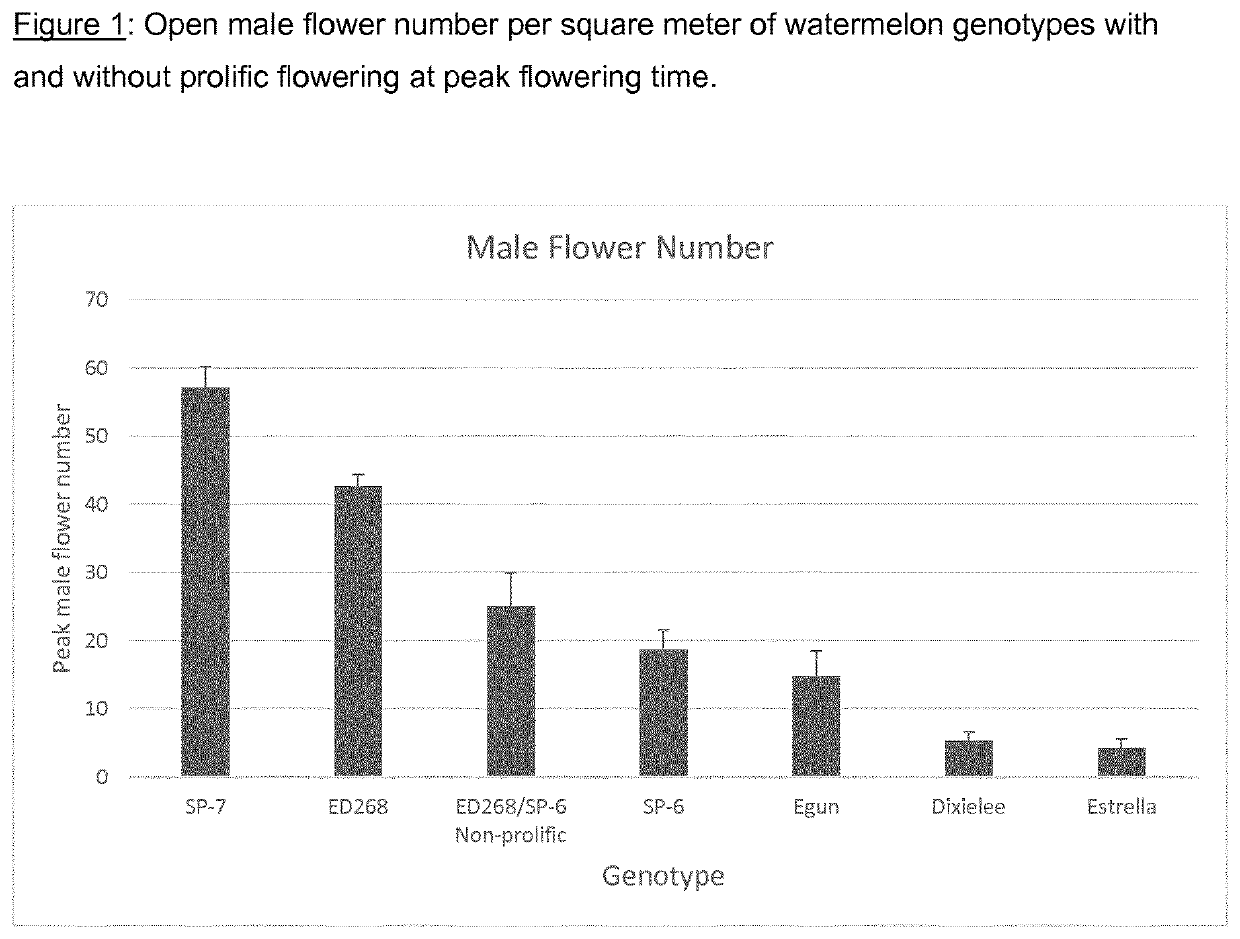Prolific flowering watermelon
- Summary
- Abstract
- Description
- Claims
- Application Information
AI Technical Summary
Benefits of technology
Problems solved by technology
Method used
Image
Examples
embodiments
[0046]In a 1st embodiment, the invention relates to a watermelon plant, particularly a cultivated watermelon plant, more particularly a diploid pollenizer type watermelon plant, wherein said plant comprises three genetic determinants together directing or controlling the expression of the prolific flowering trait, and wherein said prolific flowering plant produces at least 40 open male flowers per square meter at peak flowering time. In a further embodiment, said prolific flowering plant produces at least 45, more preferably at least 50 open male flowers per square meter at peak flowering time.
[0047]In another embodiment, the invention relates to a watermelon plant, particularly a cultivated watermelon plant, more particularly a diploid pollenizer type watermelon plant, wherein said plant comprises three genetic determinants directing or controlling the expression of the prolific flowering trait, and wherein said prolific flowering plant produces 30% more open male flowers per squar...
example 1
and Population Development
[0220]A recombinant inbred line (RIL) genetic population was constructed by hybridizing a wild watermelon accession, PI595203, [Citrullus lanatus cv “Egun”] with a modern cultivar, PI635731, [Citrullus lanatus cv “Dixielee”], self-hybridized using single seed descent until all observable phenotypic traits were fixed and each line exhibited uniform characteristics. The population (also referred to as the ED-RIL population) was cultivated in open field trials and phenotyped for various traits. This resulted in the observation of an extreme phenotype (termed “prolific flowering”) which displayed a large increase in male flower number. Line designated as ED268 was the most preferred line for increased number of male flowers. Some ED-RILs expressed prolific flowering while some did not, indicating discrete genetic control of the phenotype. Continued observation of the population revealed that prolific flowering was a heritable trait. Prolific flowering was not o...
example 2
ng
Example 2A. Method of Measuring Prolific Flowering: Male Flower Number
[0223]Plots of each genotype were cultivated in open field conditions with 24 inches (61 cm) spacing between plants. All data are from a field trial set up in a randomized complete block design having three repetitions treated as blocks. Male flower number was estimated by counting the number of open male flowers within a square meter of area. For each plot, two measurements were taken on a weekly basis. Peak flowering time was determined as the week when the most open male flowers were recorded across all plots.
PUM
| Property | Measurement | Unit |
|---|---|---|
| Fraction | aaaaa | aaaaa |
| Fraction | aaaaa | aaaaa |
| Fraction | aaaaa | aaaaa |
Abstract
Description
Claims
Application Information
 Login to View More
Login to View More - R&D
- Intellectual Property
- Life Sciences
- Materials
- Tech Scout
- Unparalleled Data Quality
- Higher Quality Content
- 60% Fewer Hallucinations
Browse by: Latest US Patents, China's latest patents, Technical Efficacy Thesaurus, Application Domain, Technology Topic, Popular Technical Reports.
© 2025 PatSnap. All rights reserved.Legal|Privacy policy|Modern Slavery Act Transparency Statement|Sitemap|About US| Contact US: help@patsnap.com

